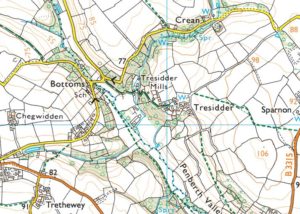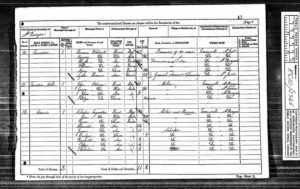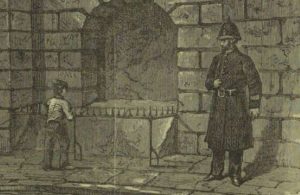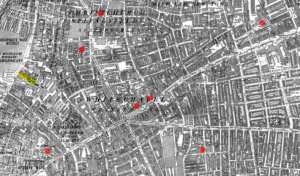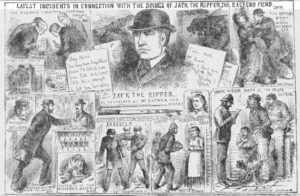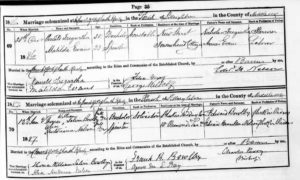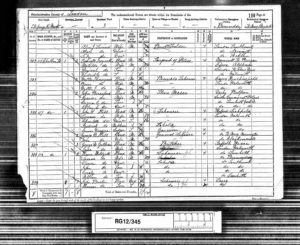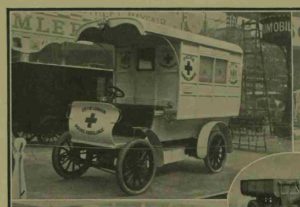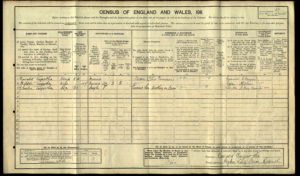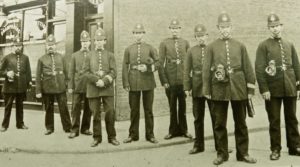Oswald Tregurtha was born in 1856, in the small settlement of Crean, on the outskirts of the village of St Buryan, located in the far west of Cornwall.
Oswald’s parents were Nicholas Tregurtha and Jane Hutchens. Nicholas worked as a miller at the water-powered corn mill known as Crean Mill, and he would eventually establish a small farm on 15 acres while also managing the local mill.
Above: Map of Crean and surrounds
In 1871 the England census shows Oswald at the age of 14, living with his family and working as a miller and farmer like his father. Over the ensuing years Oswald would ponder his future and soon made a decision that took his life in a whole new direction.
Above: 1871 England Census
At the age of twenty-three Oswald decided to become a police officer. After many goodbyes to family and friends, Oswald packed his bags and journeyed over 300 of miles north-east to the city of London. On the 11th October 1880 Oswald Tregurtha became a Constable in the Metropolitan Police.
Prior to his official start, Oswald had to make an application to the Commissioner in London, and along with his application, he was required to send certificates of character. Enquiries were then made to the people who recommended Oswald, ensuring the testimonials provided were accurate. After this, he was summoned to attend Scotland Yard for a reading and writing exam, and a physical examination conducted by the Chief Surgeon. Once passed, Oswald was considered an eligible candidate, and so was placed in a vacant position at New Street Police Station. Here he joined the preparatory class and attended morning drills for a short period of time, before being sworn in as a Constable on the above-mentioned date.
To be officially sworn in meant that Oswald took the police oath and signed the “Oath Book”. Once officially sworn in, he was required to patrol for five hours a day for one week with other experienced Constables, to gain experience before acting alone in the streets.
Over the next few years Oswald learned his job well and became accustomed to patrolling the streets of the busiest city in the world at the time. He learned that as a young Constable, he needed to gain a sound knowledge of how and when to act; and when he was called upon to act – to do so “with vigour, energy and firmness”.
Above: London police officer patrolling in 1881
Still in the infancy of his new profession, the 1881 census shows Oswald living as a resident constable, along with other young men, at the New St. Police Station in the East End of London. Because Oswald was unmarried, he could live in the Section House of the Police Station. He would have eaten in the mess with the other resident constables and would have found this to be a better and cheaper arrangement than living on his own.
If you know anything about London’s dark history, you will know that Oswald began his police career in the same area, and at the same time, as the notorious and still unidentified serial killer: Jack the Ripper. Oswald would have been involved in the countless searches and investigations for this villainous human who took the lives of at least seven young women. Two of the murders occurred within just a few blocks of the station where Oswald was working. The map below shows where the bodies of seven women were discovered, and the yellow line marks New St. Police headquarters where Oswald was stationed.
Jack the Ripper committed his crimes in the impoverished districts around Whitechapel in the East End of London. He was also called the Whitechapel Murderer and Leather Apron.
The heinous crimes received extensive newspaper coverage which ended up giving Jack the Ripper widespread and enduring international notoriety. Police officers worked day and night to try and catch him, and although there were a few a good suspects, he was never caught.
We can only wonder what went through Oswald’s mind during this time, and indeed during the many years he patroled the streets of London. As he came to understand and know the people in his community, many of them London’s poorer class, did he miss the rural life back home in Cornwall? Or did he thrive in the fast paced and ever-changing surroundings of London’s East End? Probably both.
Oswald’s police manual, a small booklet given to every recruit containing instructions and protocol, was something he probably turned to many times in his first years. It described his role in detail, including such things as how he should patrol the streets during his shift:
“he is to walk at a gentle pace, about 2 ½ miles an hour, keeping to the outer or kerb side of the street by day, and walking close to the houses by night. He must not loiter or stand in an idle and listless manner, or gossip. He is not on any account to receive drink from any one. If he requires refreshment, he can obtain the permission of his Sergeant to purchase it.”
The manual also provided directions on making an arrest:
“When called upon by a person to take another person into custody, he must be guided in a great measure by the circumstances of the case, such as the position in life of the accuser and the accused, and the nature of the charge or offence; but if he has any doubt as to how he ought to act, the safest course is to ask all the person concerned to go with him to the Station, where the Inspector will hear and determine whether the charge is to be entered or not, and the responsibility is then taken off the Constable.”
As to temperament, it stated the following:
“Perfect command of temper is indispensable. A man must not allow himself to be moved or excited by any language or threat, however violent; the cooler he keeps himself the more power he will have over his assailants. Idel or silly remarks are unworthy of notice, and if the persons making them see that they have no effect upon the Constable they will soon leave off.”
Despite the challenges Oswald faced in his new and dangerous profession, in 1886 after six years on the beat, Oswald met and married a young lady named Matilda Evans from Essex.
Above: Marriage record of Oswald Tregurtha and Matilda Evans
Five years later the 1891 England census shows Oswald and Matilda living in Bermondsey, and by this time they had two sons: 3-year-old Reginald and 1 year old Frederick Charles. The census also shows that Oswald was no longer a Constable but had been promoted to Sergeant. Further research uncovered that he had become the Sergeant of the Bow Police Station.
Above: 1891 England Census
Many changes took place in London’s police sector during Oswald’s career, one of them being the introduction of bloodhounds in 1888, and the Police Ambulance in the early 1900s.
Above: City of London Police Ambulance c1907
Oswald enjoyed a long career in the Metropolitan Police, spanning just over twenty-five years, yet it seems the memories of his youth would never leave him. After he retired in 1905, Oswald and wife Matilda, and their twenty-one-year-old son Frederick Charles, moved back to his home county of Cornwall. Purchasing a small plot in the outskirts of Redruth, Oswald took up farming, and there he remained, enjoying life on the land.
Above: 1911 England Census
Oswald died on the 7th October 1920 at the age of 64 from angina pectoris, while at home on his farm in Higher Leity, Redruth.
Matilda survived Oswald by twenty-one years; she died on the 26th January 1941 from what was described as general anasarca and cardiac failure, with her son Reginald by her side when she died. She had moved to Surrey after Oswald’s death, to live with Reginald and his family, at 75 Nork Way in Banstead.
Reginald married Lucy Whippy in London in 1913 and they had two daughters: Constance Irene Tregurtha and Olive May Tregurtha. Reginald died from coronary thrombosis while at home in Banstead, in April 1951; he was 63.
Oswald and Matilda’s youngest son, Frederick Charles, served in WW1, earning a military medal for bravery. In 1926 he emigrated to the United States and took up work in the New Jersey Zinc Company. Tragically he died in 1929 at the age of 39 from complications after a mining accident. He was buried in New Jersey with full military honours. Frederick never married and had no children.
